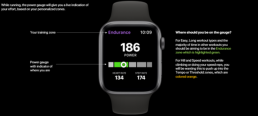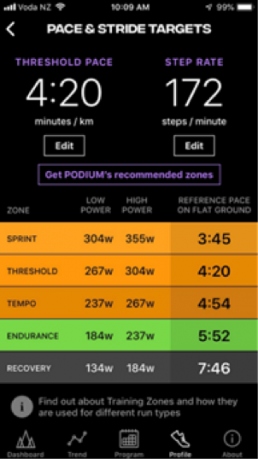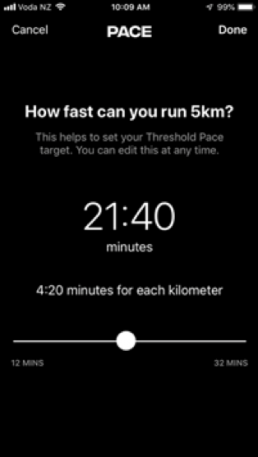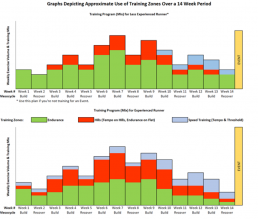(Automated Training Zones):
One of the biggest reasons that people find it hard to start running, don’t like running and get injured from running, is that they exercise too intensely!
One of the most fundamental questions for running effectively is:
“what is the correct effort to exercise at?”
We all know that running too hard is often unnecessary, will lead to discomfort during the run and an unpleasant fatigue afterwards and running too easy means not getting the results you are looking for.
We are all different, “how do I find the effort that is right for me?”
Your Training Zones:
Knowing your Training Zones which are personal to you is the key. Training Zones are usually described as 5–7 intensity levels of increasing effort, from very gentle to maximum. Each zone has a function. Here is a quick explanation from easiest to most intense:
- Recovery (Recovery)
- <60% effort/very Easy
- used for recovery and warming down.
- Endurance (Building Workout Length/Fitness)
- 60–75% effort/Easy-Medium
- used for at least 90% of your training (ALL Easy and Long workouts).
- Tempo (Easy Speed)
- 75–85% effort/Medium-Hard
- is a good zone to stay in when running up hills (Hill workouts) and used later in a training program for Half Marathon and Marathon race pace conditioning (Speed workouts).
- Threshold (Hard Speed)
- 85–95% effort/Hard-Very Hard
- used later in a training program for 5km and 10km race pace conditioning or as the ‘icing’ on your Half Marathon/Marathon ‘cake’. 😊
- Sprint (Very Hard Speed)
- >95% effort/Very Hard
- Only used for leg speed training by experienced endurance runners.
You might run in a specific zone for fat loss, fitness, endurance, speed or peaking for an event. You pick the correct zone to run in to get the results you want. Most people only need the first 2 or 3 zones.
Using Power for Effort Zones:
Podium uses a new metric called Power. We have chosen Power specifically as the best measure of effort over other measures because:
- heart rate is slow to react to changes in effort,
- and speed is responsive but only works on the flat; speed going uphill as an effort is meaningless.
This makes Power ideal as the perfect balance between usability in all conditions and responsiveness. For advanced runners, Power is also a good measure of a target work output for a goal event where heart rate is more ambiguous due to factors like fatigue.
Don’t worry, we still use heart rate to measure your body’s reaction to exercise and pace.
Easy to Use Power Gauge:
Your power is displayed as a metric and as a horizontal bar (shown below) called the PODIUM Power Gauge. This provides at-a-glance Training Zones for optimal effort on your Apple watch or iPhone.
The ‘doughnut’ on the horizontal bar below shows which Training Zone you’re in. Easier running is to the left of the bar and more intense running is to the right. (e.g. Blocks on the bar from left to right are Recovery, Endurance, Tempo, Threshold, Sprint Zones.)

Setting Your Training Zones:
Setting your Training Zones is usually annoyingly difficult. Most alternatives require you to
- use theoretical calculations that are wrong in about 50–60% of cases,
- get a Sports Science Lab test which is expensive and requires organisation,
- or you are asked to do your own running test where you gradually increase your speed to near maximum. Ouch!
None are ideal AND as you get fitter, your zones will change, which means you have to go through the whole process all over AGAIN!
Ideally, your Training Zones should MAGICALLY set themselves and stay updated! 😊
PODIUM Magic: Training Zones Set Automatically:
At Performance Lab, we run a lot, and feel your pain. So, we invented a way to get your Training Zones without you doing anything other than running as you always do!
After your initial 2 hours of total running in normal conditions, PODIUM will calculate your personal zones. (See below).

PODIUM will also continue to monitor your physiology and change your zones as your fitness changes. To our knowledge, PODIUM is the only wearable software that can automatically set your Training Zones from general running.
Manual Training Zones Option:
For the sports nerds of us, who know our training zones, you can set your zones manually. (below)

How Training Zones Fit into Your Running:
When you build up your running, the process follows the law of progression.
- Slowly build the running duration’s up in the Endurance zone.
- Emphasise hills (Tempo power zone on hills, Endurance zone on the flat) to build muscular endurance midway through the training.
- Emphasise speed training (Tempo and Threshold zones on the flat) near the end of your training block.
- Go into an Off Season (2–4 weeks, 30% of previous volumes & training mix) to ‘recharge your batteries’ and then go back to 1. 😊

PODIUM turns your Apple Watch into a high-end sports watch. Try PODIUM you’ll like it.
Please share this article with those who you think might find it useful.